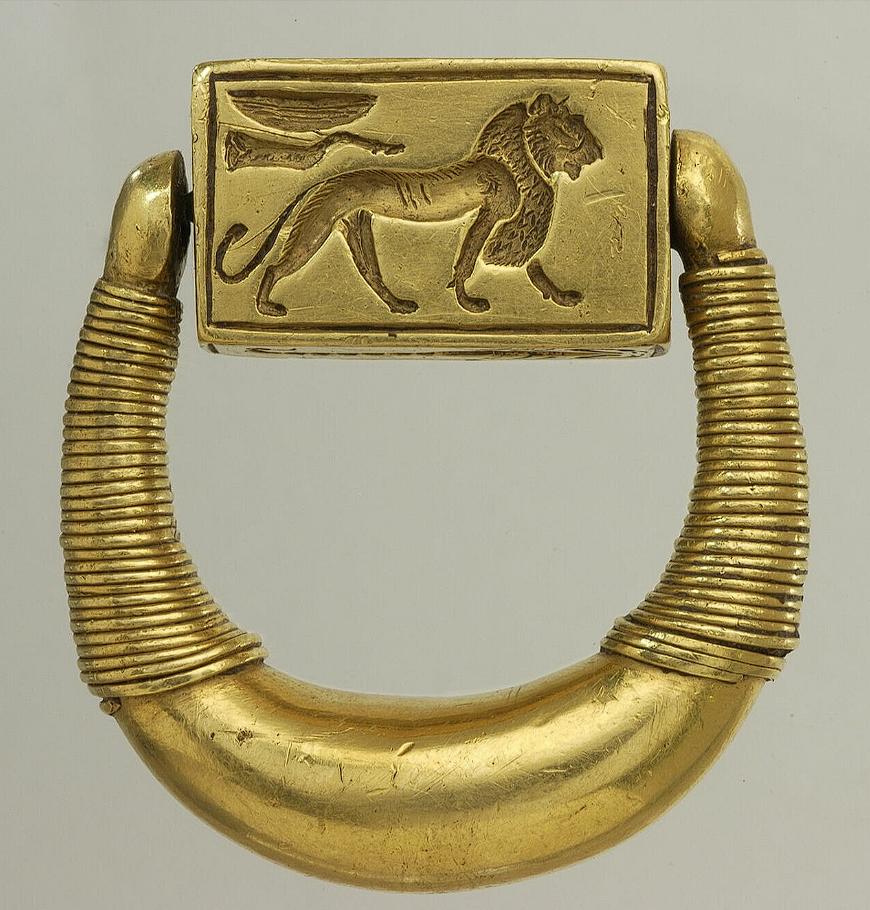From the fading light of ancient Egypt’s illustrious 18th Dynasty emerges a remarkable testament to royal craftsmanship: a delicate gold ring, a tangible relic dating back to the reign of King Horemheb (circa 1323–1295 BCE), the final pharaoh of that celebrated lineage.
A Small Object, a Powerful Statement: Symbolism in Gold
Measuring a mere 2.5 centimeters in length, this unassuming ring may appear small in scale, yet its intricate details speak volumes about the power, symbolism, and artistry of the era. Its rectangular bezel, ingeniously designed to rotate, is adorned with delicate and precisely rendered spirals, alongside a striking sunk relief depicting a majestic lion—an enduring and potent symbol of strength, courage, and the inherent authority of kingship in ancient Egyptian iconography. Adding further significance, in the upper left corner of the bezel, a short but undeniably powerful inscription is carefully etched: “strong lord.”
The Significance of “Strong Lord”: Reflecting a King’s Ascent
Such a deliberate and weighty title inscribed upon a royal ring was no mere happenstance. Horemheb’s ascent to the throne was a remarkable one. Rising through the ranks of the military to become a prominent commander, he ultimately stepped into the role of ruler, tasked with the formidable challenge of restoring order and stability to Egypt following the politically and religiously turbulent Amarna period. The inscription “strong lord” likely served as a potent reminder of Horemheb’s strength, his ability to quell unrest, and his commitment to re-establishing traditional Egyptian values and governance.
A Ring’s Journey: Adorning Royalty or Court
This exquisite gold ring, meticulously catalogued as N 747 within the esteemed collections of its current residence, may have held a significant place within the royal court of Horemheb’s reign. It could have adorned the finger of a high-ranking court official, a symbol of their status and connection to the pharaoh’s power. Alternatively, and perhaps more intriguingly, it may have even graced the hand of the king himself—serving as both a personal talisman, believed to offer protection and invoke the qualities of strength, and a clear, tangible statement of his royal authority and dominion.
A Nile Treasure in Paris: Echoes of Ancient Power
Today, this precious artifact rests far from the familiar banks of the Nile River, carefully preserved and displayed within the hallowed halls of the Louvre Museum in Paris, France. Despite its geographical displacement, the gold of the ring continues to gleam with a timeless luster, offering a captivating glint that connects the modern world to the distant grandeur of Egypt’s ancient past. The powerful roar of the symbolic lion, though silently rendered in gold, still echoes across the millennia, a potent reminder of the strength and enduring legacy of King Horemheb and the magnificent civilization he ruled.

CÁC TIN KHÁC
Mary Walton: The Forgotten Inventor Who Helped Clean Up America’s Cities
Tomb of Queen Nefertari in the Valley of the Queens, Egypt
Discover the Hypostyle Hall of the Temple of Hathor at Dendera
Venus de Losange: Unveiling the Mystery of a 20,000-Year-Old Paleolithic Icon